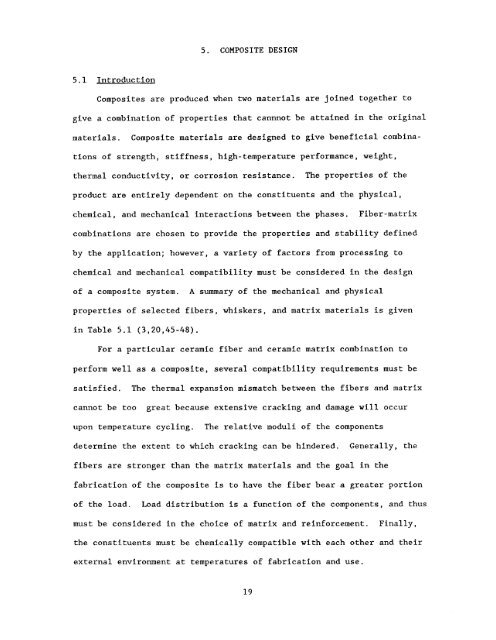Characterization and control of the fiber-matrix interface in ceramic ...
Characterization and control of the fiber-matrix interface in ceramic ...
Characterization and control of the fiber-matrix interface in ceramic ...
Create successful ePaper yourself
Turn your PDF publications into a flip-book with our unique Google optimized e-Paper software.
5. COMPOSITE DESIGN<br />
5.1 Introduction<br />
Composites are produced when two materials are jo<strong>in</strong>ed toge<strong>the</strong>r to<br />
give a comb<strong>in</strong>ation <strong>of</strong> properties that cannnot be atta<strong>in</strong>ed <strong>in</strong> <strong>the</strong> orig<strong>in</strong>al<br />
materials.<br />
Composite materials are designed to give beneficial comb<strong>in</strong>a-<br />
tions <strong>of</strong> strength, stiffness, high-temperature performance, weight,<br />
<strong>the</strong>rmal conductivity, or corrosion resistance. The properties <strong>of</strong> <strong>the</strong><br />
product are entirely dependent on <strong>the</strong> constituents <strong>and</strong> <strong>the</strong> physical,<br />
chemical, <strong>and</strong> mechanical <strong>in</strong>teractions between <strong>the</strong> phases. Fiber-<strong>matrix</strong><br />
comb<strong>in</strong>ations are chosen to provide <strong>the</strong> properties <strong>and</strong> stability def<strong>in</strong>ed<br />
by <strong>the</strong> application; however, a variety <strong>of</strong> factors from process<strong>in</strong>g to<br />
chemical <strong>and</strong> mechanical compatibility must be considered <strong>in</strong> <strong>the</strong> design<br />
<strong>of</strong> a composite system.<br />
A summary <strong>of</strong> <strong>the</strong> mechanical <strong>and</strong> physical<br />
properties <strong>of</strong> selected <strong>fiber</strong>s, whiskers, <strong>and</strong> <strong>matrix</strong> materials is given<br />
<strong>in</strong> Table 5.1 (3,20,45-48).<br />
For a particular <strong>ceramic</strong> <strong>fiber</strong> <strong>and</strong> <strong>ceramic</strong> <strong>matrix</strong> comb<strong>in</strong>ation to<br />
perform well as a composite, several compatibility requirements must be<br />
satisfied. The <strong>the</strong>rmal expansion mismatch between <strong>the</strong> <strong>fiber</strong>s <strong>and</strong> <strong>matrix</strong><br />
cannot be too<br />
great because extensive crack<strong>in</strong>g <strong>and</strong> damage will occur<br />
upon temperature cycl<strong>in</strong>g.<br />
The relative moduli <strong>of</strong> <strong>the</strong> components<br />
determ<strong>in</strong>e <strong>the</strong> extent to which crack<strong>in</strong>g can be h<strong>in</strong>dered.<br />
Generally, <strong>the</strong><br />
<strong>fiber</strong>s are stronger than <strong>the</strong> <strong>matrix</strong> materials <strong>and</strong> <strong>the</strong> goal <strong>in</strong> <strong>the</strong><br />
fabrication <strong>of</strong> <strong>the</strong> composite is to have <strong>the</strong> <strong>fiber</strong> bear a greater portion<br />
<strong>of</strong> <strong>the</strong> load. Load distribution is a function <strong>of</strong> <strong>the</strong> components, <strong>and</strong> thus<br />
must be considered <strong>in</strong> <strong>the</strong> choke <strong>of</strong> <strong>matrix</strong> <strong>and</strong> re<strong>in</strong>forcement.<br />
F<strong>in</strong>ally,<br />
<strong>the</strong> constituents must be chemically compatible with each o<strong>the</strong>r <strong>and</strong> <strong>the</strong>ir<br />
external environment at temperatures <strong>of</strong> fabrication <strong>and</strong> use.<br />
19

















